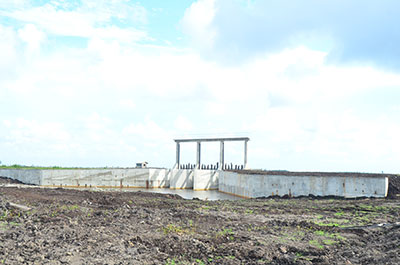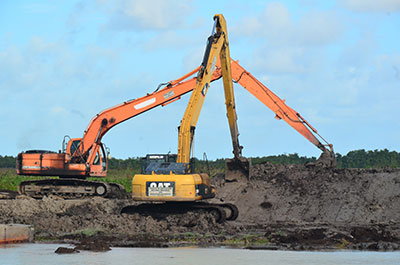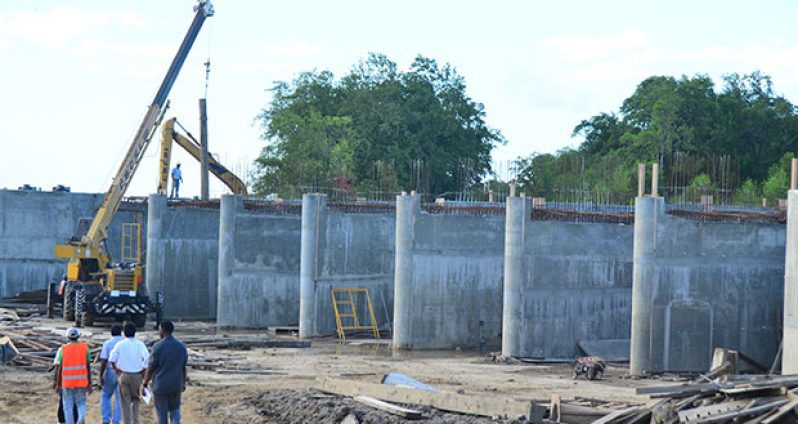WITH a $3.6B investment, the East Demerara Water Conservancy (EDWC) Northern Relief Channel, commonly referred to as Hope Canal is not without its challenges,

This is according to National Drainage and Irrigation Authority (NDIA) head Lionel Wordsworth.
Entirely funded by the Government of Guyana, the multi-billion dollar project is expected to ease the flooding concerns of residents in Mahaica/Mahaicony/Abary (MMA) areas after repeated flooding over the years had caused damage to crops and loss of livestock.
While the project remains within its budget, as stated by NDIA’s Chief Executive Officer, with some $3.2B of the total $3.6B already spent, the factors of time and climate seem to have the final say in its completion.
One challenge, the NDIA head noted was the strength of suitable clay used for the dam.“There is an area that we found there is suitable clay,” Wordsworth said, adding that this suitable clay was used to strengthen the river defence embankment to the conservancy.
The clay was then dredged from one location and transported to the next, while the intention was to use tractor-trailer services for this task, bad weather conditions left the team scrambling for solutions.
“Having recognised that, we quickly switched to having other measures in place to have continuity in the construction works,” Wordsworth said, as he alluded to the use of excavators and pontoons which eventually minimised the time taken to transfer clay some 3,000 metres up the channel to be used for strengthening and lifting the embankment.

As it relates to the ideal clay for the project, Wordsworth stated that geotechnical investigations were conducted for determining the sheer strength values derived from the soil. “We found an area where there was mixed clay material so it has a much lower sheer strength.”
The engineering team with swift action found it necessary to “reinforce the embankment with geotextile material of PP300 grade with a width of 20 cm… on one layer of the embankment on the ground level.”

The multi-billion dollar Hope Canal project which started in 2011 is separated into four components, which are being completed at the same time. One of those components is the $349M Public Road Bridge commissioned last February by President Donald Ramotar.
Similarly completed is the Head Regulator at the southern end of the channel, which will interject the East Demerara Water Conservancy acting as “a control structure to release water from the conservancy into the channel.”
Works, however, are still to be completed on the 10km Canal as well as the eight High Level Discharge Sluices gates at the northern end of the EDWC. Some controversy had fallen on the plans to have the sluices constructed as dissenting voices questioned whether eight gates would be necessary.
The capacity of the eight-gate sluice to discharge 58 cubic metres per second of water is similar to emptying 1.9B small bottles of water every second. Responding to those concerns, Wordsworth said: “It could’ve been a smaller structure but it has to be deeper, and you could’ve had continuous dredging which is costly so, of the options, the choice was to build the eight-gate sluice which gives you the same desired discharge capacity of discharging 58 cubic metres per second.”
Wordsworth called for greater interest to be taken by both the media and those observing the works to be more aware of the many technical challenges facing the project’s completion.
While a deadline of November month end still stands, the NDIA Director called for persons to “understand the huge scope of works required to put this thing in place [since] it wasn’t just a canal with two embankments and the engineering that went into it.”
The ultimate test of the project will be done when all the works have been completed and the necessary conditions are in place which requires the canal to function. The East Demerara Water Conservancy Northern Relief Canal was designed to relieve the conservancy when it moves above its full supply level.
Once that full supply level is exceeded, “then the operations manual would tell you that you [should] start opening the flood gates,” Wordsworth noted, adding that this is likely to occur in the rainy season when continuous rainfall raises the normal level of the conservancy.
(by Derwayne Wills)



.jpg)










